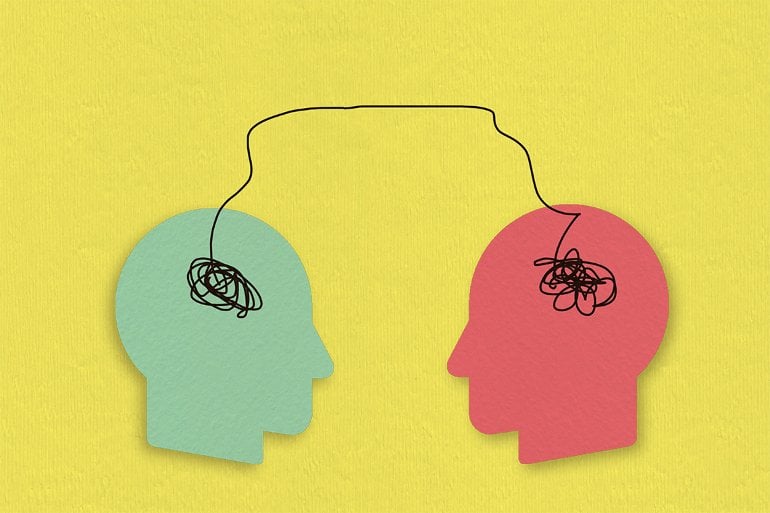Summary: People will empathize with others when they recognize them as opportunities to show empathy, but often notice the feelings with others without flagging them as an opportunity to empathize.
Source: University of Toronto
Researchers at the University of Toronto are studying our capacity for empathy, or our ability to sense and understand someone else’s emotions, and are debunking some common misconceptions along the way.
Their work, recently published in the journal Psychological Science, is potentially important since empathy is fundamental to maintaining meaningful and healthy relationships, making it a big part of our daily lives.
“We want to get a description of empathy by looking at it in everyday life, across different emotions and social contexts,” says Greg Depow, a PhD student who is studying social psychology at U of T Scarborough.
“We want to study empathy more in environments closer to how it is actually experienced in real life.”
The study, which was co-authored with Professor Michael Inzlicht, looked at perceptions of empathy in 246 American adults. Depow says one goal of the research is to fill in gaps from previous work to offer a deeper, more authentic view of empathy. This was done by looking at who is more likely to be empathetic and how often we take the opportunity to empathize per day.
The research also looked at how empathy impacts subjective well-being, which is the scientific term for happiness and sense of purpose in life.
Opportunities to empathize with others occur when one observes the emotions of another person or stranger. This can be done in person or even on social media – for example, when you notice a friend’s emotional status or posts.
The researchers found that people will empathize when they recognize the opportunity to do so, but often notice other people’s emotions without flagging them as opportunities to empathize.
“People were seeing these emotional experiences of other people, but weren’t flagging them as opportunities to empathize,” Depow says. “If you crunch the numbers a bit, it seems as though a third of emotions people see in daily life are not seen as empathy opportunities.”
Learning what differentiates missed and flagged opportunities may be key to learning how to recognize and provide opportunities empathy more successfully, Depow says.
“One thing that I’m interested in is differentiating missed opportunities from the ones people are noticing. This is important because people may be missing opportunities to connect with others and promote happiness for both parties.”
While previous studies have typically focused on how empathy is measured based on the suffering of strangers and its effects on the empathizer, it turns out people are three times more likely to empathize with positive emotions than negative ones.

“If I look just at negative emotions that people are empathizing with, that’s actually associated with reduced subjective well-being,” Depow says. “[But] because people are empathizing with positive emotions three times as often, overall empathy is associated with increased subjective well-being.”
Who we empathize with is also an important factor. Most studies tend to focus on how people empathize with strangers, but Depow says the evidence shows that people are more likely to support those who are close to them.
He adds that confidence appears to affect our experience with empathy. People who are confident about their experiences seem to experience increased levels of well-being.
“People find empathy difficult more or less in different situations and that seems to change people’s experience of empathy and the extent to which they empathize.”
The researchers also found that receiving empathy ourselves may make us more receptive to empathizing with others. By contrast, those who empathized with others were no more or less likely to notice another opportunity to empathize with someone else.
Funding: The research received support from the Social Science and Humanities Research Council of Canada.
About this empathy research news
Source: University of Toronto
Contact: Tina Adamopoulos – University of Toronto
Image: The image is credited to University of Toronto
Original Research: Closed access.
“The Experience of Empathy in Everyday Life” by Greg Depow et al. Psychological Science
Abstract
The Experience of Empathy in Everyday Life
We used experience sampling to examine perceptions of empathy in the everyday lives of a group of 246 U.S. adults who were quota sampled to represent the population on key demographics.
Participants reported an average of about nine opportunities to empathize per day; these experiences were positively associated with prosocial behavior, a relationship not found with trait measures.
Although much of the literature focuses on the distress of strangers, in everyday life, people mostly empathize with very close others, and they empathize with positive emotions 3 times as frequently as with negative emotions.
Although trait empathy was negatively associated only with well-being, empathy in daily life was generally associated with increased well-being.
Theoretically distinct components of empathy—emotion sharing, perspective taking, and compassion—typically co-occur in everyday empathy experiences.
Finally, empathy in everyday life was higher for women and the religious but not significantly lower for conservatives and the wealthy.






